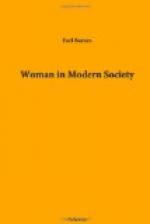There is, too, a possibility that a married woman might have a child, and a feeling that this would shock the other teachers and the children. Surely we have grown beyond this condition; the teacher could easily be given a leave of absence for a few months, or for a few years; and nowhere else could the children better meet this fact of universal existence around which our Anglo-Saxon reticence has woven such a shameful conspiracy of silence. At least, when a woman has passed the period of childbearing she could bring to the school incalculable gifts of balanced judgment and ripe understanding of life.
Meantime all the influences which have brought about the monopoly of teaching by women are increasingly operative. Every year more able women leave our high schools, normal schools and universities, with no corresponding new lines of occupation open to them. The feeling of rivalry between men and women teachers grows stronger each year. Powerful teachers’ federations, such as those in Chicago and Buffalo, composed mainly of women, are said to be using their influence to favor women. In New York City, the women teachers have compelled the city to equalize the wages of men and women, at an annual expense of $3,500,000, after a bitter fight lasting several years.
The effects of this monopoly upon the women themselves are very difficult to estimate. Some alarmists tell us that women teachers face the danger of a premature and loveless old age; that the celibate communities they form in the commonwealth are marked by pettiness and emotionalism; that the salaries paid teachers are so small that they cannot provide for sickness and old age, and that, unless pensioned by the state, some of them must one day eat the bread of charity.
On the other hand, we are told that education is the natural province of women; that teaching fits them to be good mothers and helpful citizens; that women alone can form the character of girls; and that boys are refined and perfected by the constant contact with women.
Probably neither of these statements is wholly true. It is certain that many women teachers do marry, do become the mothers of fine children, and are social forces in their communities. With advancing standards of scholarship, better salaries, old age pensions, and a popular demand for professional efficiency in teachers, it will be increasingly difficult for men to use the calling as a preparation for law and medicine, or for women to use it as a preparation for matrimony. The calling doubtless does offer a greater equivalent for marriage than most others; and many women live their mother life vicariously for other people’s children.
At the same time, however, when a woman has given fourteen years of her life to preparation for teaching, eight years in an elementary school, four in a high school, and from two to four in professional training, she has made an investment and formed habits which will make her hesitate before turning to matrimony. The independence and income will prove attractive during young maidenhood; and matrimony can hardly yield its best results to the woman who enters it after she is thirty. It is certainly true that women are decreasingly willing to enter the teaching profession; and in many parts of the country there is a chronic dearth of trained teachers.




